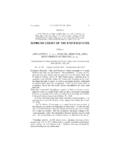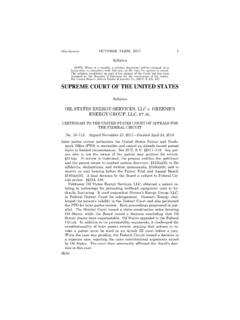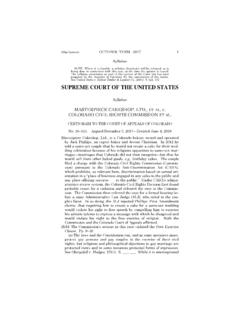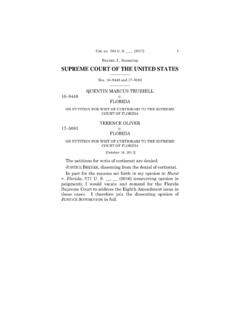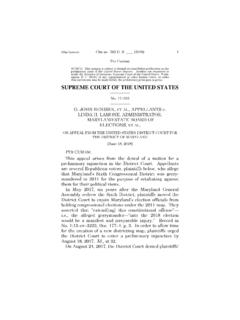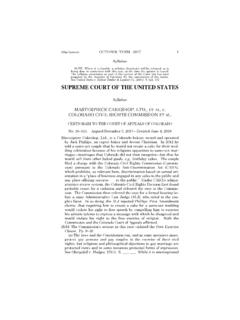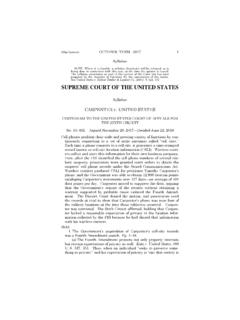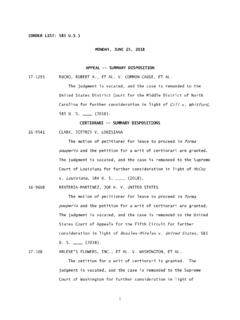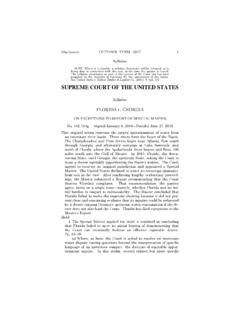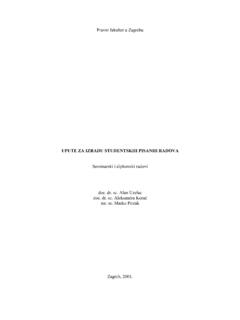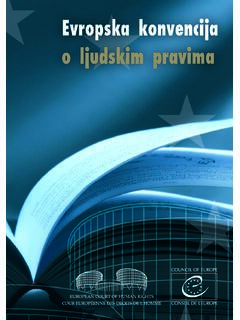Transcription of SUPREME COURT OF THE UNITED STATES
1 1 (Slip Opinion) OCTOBER TERM, 2020 Syllabus NOTE: Where it is feasible, a syllabus (headnote) will be released, as is being done in connection with this case, at the time the opinion is issued. The syllabus constitutes no part of the opinion of the COURT but has been prepared by the Reporter of Decisions for the convenience of the reader. See UNITED STATES v. Detroit Timber & Lumber Co., 200 U. S. 321, 337. SUPREME COURT OF THE UNITED STATES Syllabus GOOGLE LLC v. ORACLE AMERICA, INC. CERTIORARI TO THE UNITED STATES COURT OF APPEALS FOR THE FEDERAL CIRCUIT No. 18 956. Argued October 7, 2020 Decided April 5, 2021 Oracle America, Inc., owns a copyright in Java SE, a computer platformthat uses the popular Java computer programming language. In 2005, Google acquired Android and sought to build a new software platformfor mobile devices.
2 To allow the millions of programmers familiar withthe Java programming language to work with its new Android plat-form, Google copied roughly 11,500 lines of code from the Java SE pro-gram. The copied lines are part of a tool called an Application Pro-gramming Interface (API). An API allows programmers to call upon prewritten computing tasks for use in their own programs. Over the course of protracted litigation, the lower courts have considered (1) whether Java SE s owner could copyright the copied lines from the API, and (2) if so, whether Google s copying constituted a permissible fair use of that material freeing Google from copyright liability. In the proceedings below, the Federal Circuit held that the copied linesare copyrightable. After a jury then found for Google on fair use, the Federal Circuit reversed, concluding that Google s copying was not a fair use as a matter of law.
3 Prior to remand for a trial on damages, theCourt agreed to review the Federal Circuit s determinations as to both copyrightability and fair use. Held: Google s copying of the Java SE API, which included only those lines of code that were needed to allow programmers to put their ac-crued talents to work in a new and transformative program, was a fairuse of that material as a matter of law. Pp. 11 36. (a) Copyright and patents, the Constitution says, serve to promotethe Progress of Science and useful Arts, by securing for limited Timesto Authors and Inventors the exclusive Right to their respective Writ-ings and Discoveries. Art. I, 8, cl. 8. Copyright encourages the pro-duction of works that others might cheaply reproduce by granting the 2 GOOGLE LLC v. ORACLE AMERICA, INC.
4 Syllabus author an exclusive right to produce the work for a period of time. Be-cause such exclusivity may trigger negative consequences, Congressand the courts have limited the scope of copyright protection to ensurethat a copyright holder s monopoly does not harm the public case implicates two of the limits in the current Copyright , the Act provides that copyright protection cannot extend to anyidea, procedure, process, system, method of operation, concept, princi-ple, or discovery .. 17 U. S. C. 102(b). Second, the Act providesthat a copyright holder may not prevent another person from makinga fair use of a copyrighted work. 107. Google s petition asks theCourt to apply both provisions to the copying at issue here. To decide no more than is necessary to resolve this case, the COURT assumes for argument s sake that the copied lines can be copyrighted, and focuses on whether Google s use of those lines was a fair use.
5 Pp. 11 15. (b) The doctrine of fair use is flexible and takes account of changesin technology. Computer programs differ to some extent from manyother copyrightable works because computer programs always serve a functional purpose. Because of these differences, fair use has an im-portant role to play for computer programs by providing a context-based check that keeps the copyright monopoly afforded to computerprograms within its lawful bounds. Pp. 15 18.(c) The fair use question is a mixed question of fact and law. Re-viewing courts should appropriately defer to the jury s findings of un-derlying facts, but the ultimate question whether those facts amount to a fair use is a legal question for judges to decide de novo. This ap-proach does not violate the Seventh Amendment s prohibition oncourts reexamining facts tried by a jury, because the ultimate questionhere is one of law, not fact.
6 The right of trial by jury does not include the right to have a jury resolve a fair use defense. Pp. 18 21.(d) To determine whether Google s limited copying of the API hereconstitutes fair use, the COURT examines the four guiding factors setforth in the Copyright Act s fair use provision: the purpose and char-acter of the use; the nature of the copyrighted work; the amount and substantiality of the portion used in relation to the copyrighted work as a whole; and the effect of the use upon the potential market for or value of the copyrighted work. 107. The COURT has recognized thatsome factors may prove more important in some contexts than in oth-ers. Campbell v. Acuff-Rose Music, Inc., 510 U. S. 569, 577. Pp. 21 35. (1) The nature of the work at issue favors fair use. The copiedlines of code are part of a user interface that provides a way for pro-grammers to access prewritten computer code through the use of sim-ple commands.
7 As a result, this code is different from many other types of code, such as the code that actually instructs the computer to 3 Cite as: 593 U. S. ____ (2021) Syllabus execute a task. As part of an interface, the copied lines are inherently bound together with uncopyrightable ideas (the overall organization ofthe API) and the creation of new creative expression (the code inde-pendently written by Google). Unlike many other computer programs, the value of the copied lines is in significant part derived from the in-vestment of users (here computer programmers) who have learned theAPI s system. Given these differences, application of fair use here isunlikely to undermine the general copyright protection that Congress provided for computer programs. Pp. 21 24. (2) The inquiry into the the purpose and character of the useturns in large measure on whether the copying at issue was trans-formative, , whether it adds something new, with a further pur-pose or different character.
8 Campbell, 510 U. S., at 579. Google s limited copying of the API is a transformative use. Google copied only what was needed to allow programmers to work in a different compu-ting environment without discarding a portion of a familiar program-ming language. Google s purpose was to create a different task-related system for a different computing environment (smartphones) and tocreate a platform the Android platform that would help achieve and popularize that objective. The record demonstrates numerous ways in which reimplementing an interface can further the development of computer programs. Google s purpose was therefore consistent withthat creative progress that is the basic constitutional objective of cop-yright itself. Pp. 24 28. (3) Google copied approximately 11,500 lines of declaring code from the API, which amounts to virtually all the declaring code needed to call up hundreds of different tasks.
9 Those 11,500 lines, however, are only percent of the entire API at issue, which consists of million total lines. In considering the amount and substantiality ofthe portion used in this case, the 11,500 lines of code should be viewed as one small part of the considerably greater whole. As part of an in-terface, the copied lines of code are inextricably bound to other lines ofcode that are accessed by programmers. Google copied these lines not because of their creativity or beauty but because they would allow pro-grammers to bring their skills to a new smartphone computing envi-ronment. The substantiality factor will generally weigh in favor of fair use where, as here, the amount of copying was tethered to a valid,and transformative, purpose. Pp. 28 30.(4) The fourth statutory factor focuses upon the effect of the cop-ying in the market for or value of the copyrighted work.
10 107(4).Here the record showed that Google s new smartphone platform is nota market substitute for Java SE. The record also showed that Java SE s copyright holder would benefit from the reimplementation of its interface into a different market. Finally, enforcing the copyright on 4 GOOGLE LLC v. ORACLE AMERICA, INC. Syllabus these facts risks causing creativity-related harms to the public. When taken together, these considerations demonstrate that the fourth fac-tor market effects also weighs in favor of fair use. Pp. 30 35. (e) The fact that computer programs are primarily functional makesit difficult to apply traditional copyright concepts in that technologicalworld. Applying the principles of the COURT s precedents and Congress codification of the fair use doctrine to the distinct copyrighted workhere, the COURT concludes that Google s copying of the API to reimple-ment a user interface, taking only what was needed to allow users to put their accrued talents to work in a new and transformative pro-gram, constituted a fair use of that material as a matter of law.
